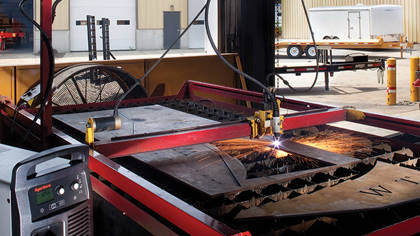Automated CNC plasma cutting: Putting it all together
Sometimes its good to get back to basics, so here's a post that covers one of the most common automated cutting methods in use today, cutting on an X-Y table.
Getting a better understanding of what all the different parts do can help you when assembling your own CNC plasma table kit or DIY CNC plasma table. When looking at CNC plasma table designs, you are likely to come across several components. Here’s a look at what each does using the human body as an analogy.
CNC – The Computer Numeric Control (CNC) is the brain of your system. It tells the other components (and even people!) what to do. In other words, your CNC is the main communication interface between the operator and the machine. It does this by converting the part program into signals that are then used to communicate things like plasma cut speed, cut direction, and other cutting parameters.
Cables and Wiring – All tables have wires and cables to connect the CNC to the power supply and other components. These are the nerves of your system.
Drive motors and gear rack – Moving the torch up, down, and around the CNC plasma table requires the use of drive amplifiers, motors and a gear rack. These are your muscles working to translate commands from the CNC into physical motion.
Table frame and slats – Continuing with our human body analogy, the CNC plasma table itself is your skeleton. These are the bones that physically support the movement of the cutting tools.
THC – If the CNC is the brain of your system, the Torch Height Control (THC) is your system’s eyes. Using arc voltage, it ensures your torch or cutting head doesn’t get too close or far from the plate. The THC:
- Performs Initial Height Sensing (IHS) by starting at the last retract height, lowering to the plate to establish the plate height, and retracting to the pierce height
- Regulates the height of the torch throughout the plasma cutting process
- Helps your system to achieve the required cut quality
- Helps with consumable life
- Protects your torch or cutting head from collisions with the plate
Torch or Cutting head – This serves as the hand or arm of your system, actually executing on the commands given by the CNC.
Fume control system – Whether using water or down-draft, the fume control systems acts as your systems' lungs, liver, and kidneys, working to dispose of the waste produced during the cutting process.
Power Supply – Last but not least is the power supply. This acts as the heart of your system, pumping the needed energy to the table.
Whether you buy a turnkey CNC plasma table or go the do-it-yourself route and are building your own affordable CNC plasma table, you will need to make sure you have all of the components listed above.
Thanks to Hypertherm's Product Application Engineers for this great analogy. What do you think? What other components would you include?


